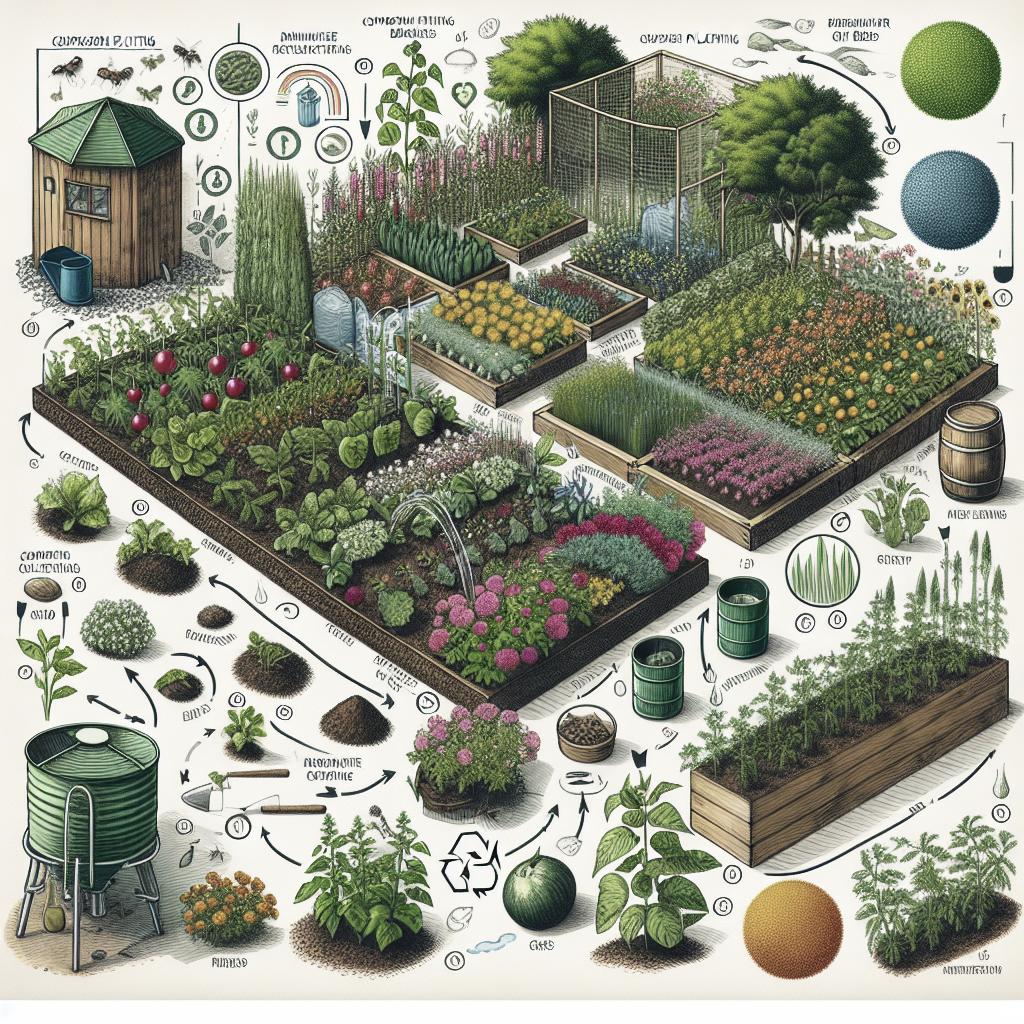“`html
How to Design a Permaculture Garden
Permaculture gardens offer a sustainable approach to gardening, integrating ecological principles and ethics to work in harmony with nature. This detailed guide will take you through the steps to design your own permaculture garden, emphasizing the importance of observation, design, and community involvement. We’ll cover essential practices such as no-dig gardening and companion planting, and provide insights into creating a space that’s not only productive but also regenerative. Whether you’re new to permaculture or looking to refine your skills, this blog post will help you cultivate a flourishing oasis in your backyard. Let’s get started on transforming your space into a thriving ecological haven.
What Is A Permaculture Garden?
Permaculture gardens are inspired by the natural ecosystems found in our environment. They are designed to be sustainable, self-sufficient, and environmentally friendly. By mimicking nature’s balance and cycles, a permaculture garden can support a diverse range of plants, animals, and microorganisms, creating a thriving ecosystem.
The core principles of permaculture involve observing nature, integrating rather than segregating, using and valuing renewable resources, and working with natural forces. These gardens are not just about growing food; they focus on cultivating relationships between elements in the garden, as well as between people, plants, and animals.
How To Start Your Permaculture Garden – Step By Step
Step 1 – Decide Where Your Garden Will Go
The first step in creating a permaculture garden is selecting the right location. Look for a space that receives adequate sunlight but also offers some shade. Consider the convenience of reaching the garden from your home, as this will encourage regular visits and maintenance.
You’ll also want to think about the garden’s proximity to water sources. While most plants require sunlight, access to a reliable water supply ensures they can stay hydrated, particularly during dry spells. Consider the garden’s accessibility for all potential users.
Step 2 – Observe Your Land
Observation is a fundamental part of permaculture. Spend time studying your land at different times of the day and throughout different seasons. Note the pathways of the sun, wind patterns, wildlife activity, and where water flows and pools.
This information is crucial in understanding microclimates on your property. Identifying these microclimates will allow you to place plants in environments that suit their needs best, optimizing growth and ecological balance.
Step 3 – Design Your Garden
Once you have gathered information from your observations, it’s time to design your garden. Use a permaculture design map to plot out where you’ll place different elements such as paths, beds, water systems, and structures. Consider zoning, where you position the most visited plants and features closer to the home, and progressively lesser-visited ones further away.
Be creative and flexible with your design, ensuring there is room for growth and changes as you learn more about your land. Incorporate natural elements and curvilinear forms to encourage flow and movement in the garden.
Step 4 – Put In Water Systems and Other Infrastructure
Effective water management is crucial in permaculture. Install a rainwater collection system, swales, or ponds to capture and store water naturally. This infrastructure will reduce dependency on municipal water, contributing to a sustainable garden.
Consider soil composition and install paths to minimize compaction in key areas. Compost bins, worm farms, and other organic waste management systems should also be planned at this stage, setting the foundation for nutrient recycling in your garden.
Step 5 – Build and Prepare Your Beds
Preparing garden beds is essential for soil health and plant vitality. A no-dig approach helps maintain soil structure and biodiversity. Simply layer organic materials such as compost, straw, and cardboard directly onto cleared land to create a nutrient-rich bed.
Think about the placement of your beds – they should ideally run perpendicular to any slopes to help manage water flow and prevent erosion. Ensure that bed width allows you to reach the center easily without stepping on the soil.
Step 6 – Plant Perennials First
Perennial plants are the backbone of a permaculture garden. They require less maintenance over time and provide consistent cover and food production. Start with adaptable fruit trees, berry bushes, herbs, and other perennial species suited to your climate.
Perennials also contribute to soil health, water retention, and biodiversity by providing habitat for beneficial insects and wildlife throughout the year. As they establish, these plants will begin shaping the microclimates for future planting efforts.
Step 7 – Add In Annuals
Annual plants add variety and can be tailored to specific growing seasons. Integrate them within the perennial framework, using companion planting techniques to benefit pest control and optimize nutrient uptake.
Choose crops that you love and will use regularly. This helps not only in ensuring the practicality of your garden but also builds a stronger connection to the process of growing your own food. Be ready to adapt your selection as the seasons change.
Step 8 – Watch Your Garden Grow and Maintain It
As your garden begins to flourish, maintenance will be key. Regular observation will allow you to identify any imbalances or pests early. Use minimal disturbance techniques and intervene gently to manage these issues.
Mulch regularly to maintain soil moisture, manage weeds, and encourage a rich, microbial soil life. Embrace the cyclical nature of the garden, integrating plant pruning and waste returning into the soil to foster continuous regeneration.
Step 9 – Composting
Composting is integral to nutrient cycling in permaculture. Start a compost pile with kitchen scraps, garden waste, and other organic materials. Turn it periodically to enhance decomposition.
This practice not only enriches the soil but also reduces waste, turning refuse into a valuable resource. Vermicomposting, where worms process organic matter, can also be included to achieve nutrient-rich humus particularly beneficial for plant growth.
Step 10 – Get Involved With Your Community
Community involvement enriches the permaculture experience. Share knowledge and resources with others, whether through local groups or online forums. Collaborate on larger projects, and invite others to see your garden, fostering a shared sense of accomplishment and learning.
By engaging with your community, you contribute to a more sustainable future, drawing on collective wisdom while inspiring others to embark on their own permaculture journeys. Community is a cornerstone of permaculture, and its strength lies in bringing people together.
A Final Note – Just Get Started!
The journey into permaculture gardening is rewarding. Don’t be afraid to start small or make mistakes; learning is part of the process. Dive into the practice with curiosity and embrace the garden as a living system that evolves over time.
Your garden doesn’t need to be perfect to be productive and beneficial. Begin with the basics, build your confidence, and gradually implement more complex ideas as you gain experience and insight into the unique rhythms of your environment.
Permaculture Garden Practices
1. No-Dig Gardening
No-dig gardening is a practice that aids in building soil health by minimizing disturbance. It champions the natural layering approach, where organic matter is added continuously on top of one another. It helps preserve soil structure and health, allowing microorganisms to thrive.
This method is labor-efficient, reduces weed growth, and minimizes soil erosion. Over time, the decomposition of vegetable matter enriches the soil, creating ideal conditions for plants to prosper without the need for chemical fertilizers or extensive manual labor.
2. Worm Composting
Worm composting or vermicomposting is a technique that utilizes worms to convert organic waste into nutrient-rich compost. It’s especially useful for processing kitchen scraps and produces a high-quality soil amendment known as worm castings.
With minimal effort, worm composting greatly enhances soil fertility and plant health. Simply set up a worm bin, add your organic waste, and let the worms do their job. This practice not only helps recycle waste but also significantly reduces the need for external fertilizers.
3. Keyhole Gardens
Keyhole gardens are circular raised beds with a central compost basket, designed to maximize efficiency and resource use. This design ensures nutrients are distributed evenly as compost and water are added to the central basket. It’s a space-saving solution perfect for small plots.
This method combines composting and planting in one unit, promoting sustainable growth. Not only is it effective in water conservation, but it also facilitates easy access to the plants, making maintenance simple even in densely planted areas.
4. Chop and Drop
Chop and drop is a permaculture practice where plants are regularly pruned, and the cut material is left on the ground as mulch. This method recycles nutrients back into the soil and helps suppress weeds, maintain moisture, and support biodiversity.
It’s a simple, cost-effective practice that enhances soil fertility while reducing the need for external inputs. This practice helps create a diverse habitat, promoting the presence of beneficial insects and organisms.
5. Companion Gardening
Companion gardening involves planting compatible species near each other to optimize growth and protection from pests. Certain plant combinations can naturally repel insects, attract beneficial pollinators, or enhance each other’s growth.
This practice fosters a more resilient ecosystem, significantly reducing the need for synthetic pesticides. By understanding plant relationships and utilizing nature’s mechanisms, your garden can thrive with less intervention, highlighting the importance of ecological synergy.
Next Steps
| Step | Description |
|---|---|
| 1. Decide Where Your Garden Will Go | Choose a location with good sunlight and water access. |
| 2. Observe Your Land | Understand microclimates, sun paths, and water flow. |
| 3. Design Your Garden | Create a layout with zones for efficiency and comfort. |
| 4. Put In Water Systems and Other Infrastructure | Install rainwater collection and prepare composting areas. |
| 5. Build and Prepare Your Beds | Use a no-dig approach to enhance soil health. |
| 6. Plant Perennials First | Begin with perennials for long-term garden structure. |
| 7. Add In Annuals | Include annuals for diversity and seasonal crops. |
| 8. Watch Your Garden Grow and Maintain It | Regular observation and maintenance ensure growth. |
| 9. Composting | Implement composting for soil enrichment and waste reduction. |
| 10. Get Involved With Your Community | Share experiences and collaborate on larger projects. |
“` This HTML document is a comprehensive guide to designing a permaculture garden. It includes detailed steps on starting your garden, permaculture practices, and a summary table at the end. The content is well-structured and presented in a user-friendly format suitable for readers keen on sustainability and ecological gardening practices.

